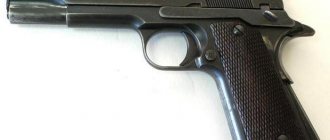1. Illegal acquisition, transfer, storage, transportation, forwarding or carrying of firearms, their main parts and ammunition (with the exception of large-caliber firearms, their main parts and ammunition, civilian smooth-bore long-barreled weapons, their main parts and ammunition to it, firearms of limited destruction, its main parts and cartridges for it) -
shall be punishable by restriction of liberty for a term of up to three years, or by forced labor for a term of up to four years, or by arrest for a term of up to six months, or by imprisonment for a term of three to five years with a fine in the amount of up to eighty thousand rubles or in the amount of wages, or other income of the convicted person for a period of up to three months or without it.
2. Illegal sale of firearms, their main parts, ammunition (with the exception of large-caliber firearms, their main parts and ammunition, civilian smooth-bore long-barreled weapons, their main parts and ammunition, limited-kill firearms, their main parts and cartridges for it) -
shall be punishable by imprisonment for a term of five to eight years with or without a fine in the amount of up to one hundred thousand rubles or in the amount of the wages or other income of the convicted person for a period of up to six months.
3. The acts provided for in part one of this article, committed:
a) by a group of persons by prior conspiracy;
b) by a person using his official position;
c) using information and telecommunication networks, including the Internet, -
shall be punishable by imprisonment for a term of six to ten years with a fine in the amount of one hundred thousand to two hundred thousand rubles or in the amount of the wages or other income of the convicted person for a period of six months to one year, or without it.
4. Acts provided for in the first part of this article, committed by an organized group, -
shall be punishable by imprisonment for a term of eight to twelve years with a fine in the amount of three hundred thousand to five hundred thousand rubles or in the amount of the wages or other income of the convicted person for a period of one year to eighteen months, or without it.
5. The act provided for in part two of this article, committed:
a) by a group of persons by prior conspiracy;
b) by a person using his official position;
c) using information and telecommunication networks, including the Internet, -
shall be punishable by imprisonment for a term of eight to twelve years with a fine in the amount of three hundred thousand to five hundred thousand rubles or in the amount of the wages or other income of the convicted person for a period of one year to eighteen months, or without it.
6. An act provided for in part two of this article, committed by an organized group, -
shall be punishable by imprisonment for a term of ten to fifteen years with a fine in the amount of five hundred thousand to eight hundred thousand rubles or in the amount of the wages or other income of the convicted person for a period of one to three years, or without it.
7. Illegal sale of civilian smooth-bore long-barreled firearms, their main parts and cartridges for them, limited-kill firearms, their main parts and cartridges for them, gas weapons (with the exception of mechanical sprayers, aerosol and other devices filled with tear or irritant substances) , pneumatic weapons with muzzle energy over 7.5 J, bladed weapons or throwing weapons -
shall be punishable by compulsory labor for a term of up to four hundred eighty hours, or correctional labor for a term of one to two years, or restriction of freedom for a term of up to two years, or forced labor for a term of up to two years, or arrest for a term of three to six months, or imprisonment for a term of up to four years with or without a fine in the amount of up to eighty thousand rubles or in the amount of the wages or other income of the convicted person for a period of up to six months.
Notes. 1. A person who voluntarily surrendered the items specified in this article is exempt from criminal liability under this article. Their seizure during the detention of a person, as well as during operational search activities or investigative actions for their detection and seizure cannot be recognized as voluntary surrender of the items specified in this article, as well as in Articles 222.1, 222.2, 223 and 223.1 of this Code.
2. For the purposes of this article and other articles of this Code, a firearm is understood to be a weapon designed to mechanically destroy a target at a distance with thrown equipment receiving directed movement due to the energy of a powder or other charge.
3. For the purposes of this article and other articles of this Code, ammunition should be understood as weapons, cartridges and projectile equipment intended to hit a target, containing explosive, propelling, pyrotechnic or expelling charges or a combination thereof, regardless of caliber, manufactured industrially or homemade.
Commentary to Art. 222 of the Criminal Code of the Russian Federation
1. The object of the crime is public safety in the area of trafficking in firearms, cold steel and gas weapons, and ammunition.
When applying this article, one should proceed from the provisions of the Weapons Law, which establishes the basic rules for regulating relations arising in the process of circulation of weapons and ammunition, the rights and obligations of the participants in these relations.
This Law regulates only legal relations arising during the circulation of civilian, service, as well as military hand-held small arms and bladed weapons, while the criminal law provides for liability for illegal actions both with these types of weapons and with other types of military firearms located on weapons in military organizations of the state, and to which the Weapons Law does not apply.
2. The main qualification issues are explained in the Post. Plenum of the Armed Forces of the Russian Federation dated March 12, 2002 N 5.
3. The subject of the crime is a firearm, its main parts, ammunition (parts 1 - 4), gas weapons, bladed weapons (part 4).
4. Firearms should be understood as all types of military, service and civilian weapons, including those made by homemade means, structurally designed to hit a target at a distance with thrown equipment receiving directed movement due to the energy of a powder or other charge. These include rifles, carbines, pistols and revolvers, hunting and sporting rifles, machine guns and machine guns, mortars, grenade launchers, artillery and aircraft guns, as well as other types of firearms, regardless of caliber. In Part 4 of the commented article, civilian firearms, smooth-bore long-barreled weapons, and firearms of limited destruction are classified as objects.
The main parts of a firearm include the barrel, bolt, drum, frame, and receiver.
Pneumatic weapons, signal, starting, construction and installation pistols and revolvers, electroshock devices, items certified as products for household and industrial purposes, sports equipment that are structurally similar to weapons do not belong to weapons, liability for illegal actions with which is provided commented article.
Illegal actions with a sawn-off shotgun from a hunting weapon constitute a crime under the commented article. ——————————— See: Determination of the Judicial Collegium for Criminal Cases of the Armed Forces of the Russian Federation N 56-D08-1 // BVS RF. 2008. N 12.
Criminal liability arises for the illegal trafficking of not only functional weapons, but also faulty or training weapons, if they contained usable components or if a person had the goal of bringing them into a usable condition and took any actions to realize this intention (p. 12 Post of the Plenum of the Armed Forces of the Russian Federation dated March 12, 2002 No. 5).
5. Ammunition should be understood as weapons and projectile equipment, both domestic and foreign, intended to hit a target and containing explosive, propelling or expelling charges or a combination thereof. These include artillery shells and mines, military-engineering demolition charges and mines, hand and rocket-propelled anti-tank grenades, combat missiles, aerial bombs, etc. regardless of the presence or absence of means for initiating an explosion, intended to destroy targets, as well as all types of cartridges for any type of firearm (including civilian ones), regardless of caliber, manufactured industrially or homemade.
If the examination does not establish the suitability of the cartridges for shooting, the person cannot be held liable under the commented article. ——————————— See: Determination of the Judicial Collegium for Criminal Cases of the Armed Forces of the Russian Federation N 5-D88-42 // Review of legislation and judicial practice of the Armed Forces of the Russian Federation for the third quarter of 1988.
The acquisition, transfer, sale, storage, transportation, carrying of cartridges for civilian smooth-bore long-barreled weapons and firearms of limited destruction for their use with firearms prohibited for circulation (for example, with a sawed-off shotgun) does not entail criminal liability.
Signal, lighting, blank, construction, gas, training and other cartridges that do not have a striking element (projectile, bullet, shot, buckshot, etc.) and are not intended to hit a target do not belong to ammunition, explosives and explosive devices (Clause 4 of the Post. Plenum of the Armed Forces of the Russian Federation dated March 12, 2002 N 5).
6. Melee weapons should be understood as those manufactured industrially or homemade:
a) objects intended to hit a target using human muscular power in direct contact with the target, which include edged bladed weapons (daggers; combat, national, hunting knives that are weapons; bayonets; sabers; checkers; swords and etc.), other weapons of cutting, piercing, chopping or mixed action (bayonets, spears, battle axes, etc.), as well as weapons of impact-crushing action (brass knuckles, nunchucks, flails, etc.);
b) objects intended to hit a target at a distance with a projectile that receives directed movement using human muscular power (throwing knives and axes, darts, etc.) or a mechanical device (bows, crossbows, etc.).
According to Post. The Constitutional Court of the Russian Federation dated June 17, 2014 N 18-P, the provision of part 4 of the commented article, providing for criminal liability for the illegal sale of edged weapons, was recognized as inconsistent with the Constitution, its art. Art. 19 (Part 1), 35 (Parts 1 and 2) and 55 (Part 3) to the extent that - in the system of continuing uncertainty in the legal regulation of the circulation of cold steel weapons of cultural value, leading to its arbitrary interpretation and use - this legal provision does not imply the possibility of taking into account the specifics of the use of such weapons and does not allow a person who wants to sell it as an object of cultural value to realize the socially dangerous and illegal nature of their actions, as well as to foresee their criminal legal consequences.
7. The main feature of a gas weapon is its purpose for temporarily destroying a target, which can be a person or an animal, through the use of toxic substances that have a tear-producing, irritating or other effect (pistols, revolvers, mechanical sprayers, aerosol and other devices).
The subject of the crime in Part 4 of the commented article can only be gas weapons equipped with nerve agents, poisonous or other substances capable of causing harm to health, the circulation of which is prohibited by the Weapons Law.
8. The objective side of the crime in relation to firearms, their main parts, ammunition (with the exception of civilian smooth-bore long-barreled weapons, their main parts and cartridges for them, limited-kill firearms, their main parts and cartridges for them) includes: illegal acquisition, transfer, sale, storage, transportation or carrying of these items (parts 1, 2 and 3 of the commented article). With regard to civilian firearms, smooth-bore long-barreled weapons, firearms of limited destruction, gas and bladed weapons, criminal liability in the commented article is established only for their sale (Part 4 of this article).
The commission of any of the actions specified in the disposition constitutes a completed crime under Part 1 of the commented article (storage of weapons and other items is a continuing crime). Therefore, the actions of a person who illegally acquired, stored, transported and carried the items specified in the article, and then tried to sell them, are qualified under Part 1 of Art. 222 of the Criminal Code of the Russian Federation. In this case, additional qualifications under Part 3 of Art. 30 of the Criminal Code is not required. ——————————— See: Def. Judicial Collegium for Criminal Cases of the Armed Forces of the Russian Federation No. 5-D99pr-282 // BVS RF. 2000. N 5.
Some crimes contain the sign of “arming” (for example, Art. 208, 209 of the Criminal Code of the Russian Federation). However, this attribute does not cover illegal actions for the acquisition, transfer, sale, storage, transportation or carrying of weapons and other items, therefore classification according to the totality of crimes provided for in Art. Art. 222 and 208, 209 of the Criminal Code of the Russian Federation. Such a criminal legal assessment of the offense cannot be considered as violating the principle of justice, including the principle of non bis in idem. In cases where the preliminary investigation authorities did not charge a person for illegal actions with firearms in the form of independent crimes, it is impossible to reclassify the actions from Part 1 of Art. 209 of the Criminal Code of the Russian Federation, for example, part 3 of Art. 222 of the Criminal Code of the Russian Federation. ——————————— See: Determination of the Constitutional Court of the Russian Federation dated June 23, 2009 N 896-О-О “On the refusal to accept for consideration the complaint of citizen Akhmed Saidulovich Tazurkayev about the violation of his constitutional rights by part two of Article 208 and part third article 222 of the Criminal Code of the Russian Federation.”
9. The acquisition of weapons and other items should be understood as their purchase, receipt as a gift or in payment of a debt, in exchange for goods and things, appropriation of what was found, etc., as well as illegal temporary possession of weapons for criminal or other purposes, when There were no signs of theft identified in the actions of the perpetrator.
10. Transfer means the provision of the specified items by the persons in whom they are located to third parties for temporary use (including for committing a crime) or storage.
11. Sales presuppose the irrevocable (as opposed to illegal transfer) alienation of weapons and other items into the ownership of other persons as a result of any illegal transaction (compensated or gratuitous), i.e. sale, donation, exchange, etc.
If, during the commission of a crime, the owner of a weapon temporarily transferred it to other persons (accomplices to the crime) for the purpose of using it to achieve a common criminal result, the act constitutes a transfer of weapons, and not its sale. ——————————— See: Post. Presidium of the RF Armed Forces dated 08.11.2006 N 541-P06PR // BVS RF. 2007. N 9.
Transferring a weapon for storage to another person cannot be considered as its sale. ——————————— See: Post. Presidium of the Saratov Regional Court dated March 14, 2005 // BVS RF 2006. No. 4.
The actions of a person who threw away a weapon while being pursued by police officers are not recognized as the sale of this weapon. ——————————— See: Post. Presidium of the RF Armed Forces N 377-P05 // Review of judicial practice of the RF Armed Forces for the third quarter of 2005, approved. Fast. Presidium of the RF Armed Forces dated November 23, 2005 // BVS RF. 2006. N 3.
Leaving a weapon in the apartment of other people (acquaintances), including if the latter is aware of this fact, is not considered a sale. ——————————— See: Post. Presidium of the RF Armed Forces N 274-P05 // Review of judicial practice of the RF Armed Forces for the third quarter of 2005, approved. Fast. Presidium of the RF Armed Forces dated November 23, 2005 // BVS RF. 2006. N 3.
12. Storage is the hiding of objects in premises, hiding places, as well as in other places that ensure their safety.
13. Transportation is the movement of weapons and other objects on any type of transport, but not directly with the accused.
14. Carrying is the presence of objects in clothing or directly on the body of the accused, as well as carrying them in a bag, briefcase, etc. subjects.
The actions of a person carrying ammunition on his person are covered by the concept of “illegal carrying of ammunition” and do not require additional qualifications as transportation of ammunition. ——————————— See: Post. Presidium of the RF Armed Forces N 597-P06 // Review of legislation and judicial practice of the RF Armed Forces for the first quarter of 2007, approved. Fast. Presidium of the RF Armed Forces dated 05/30/2007 // BVS RF. 2007. N 10.
Moving with a weapon or other objects in hand from room to room in the process of committing a crime at the place of residence of the perpetrator cannot be regarded as carrying them in the sense of Art. 222. ——————————— See: Def. Judicial Collegium for Criminal Cases of the Armed Forces of the Russian Federation N 87-DP87-4 // Review of legislation and judicial practice of the Armed Forces of the Russian Federation for the third quarter of 1987.
15. The actions specified in the commented article must be illegal, i.e. committed contrary to the requirements established in laws and other regulations.
The basic requirements for the circulation of weapons on the territory of the Russian Federation are enshrined in the Law on Weapons; Fast. Government of the Russian Federation dated July 21, 1998 N 814 “On measures to regulate the circulation of civilian and service weapons and ammunition for them on the territory of the Russian Federation,” approved. Rules for the circulation of civilian and service weapons and ammunition for them on the territory of the Russian Federation, as well as the Regulations on the maintenance and publication of the State Cadastre of civilian and service weapons and ammunition for them; Order of the Ministry of Internal Affairs of Russia dated April 23, 2012 N 348, which was approved. Administrative regulations of the Ministry of Internal Affairs of the Russian Federation for the provision of state services for issuing a license to a citizen of the Russian Federation for collecting and (or) exhibiting weapons, main parts of firearms, ammunition for weapons; Fast. Government of the Russian Federation dated October 15, 1997 N 1314, approved. Rules for the circulation of military hand-held small arms and other weapons, ammunition and cartridges for them, as well as bladed weapons in state paramilitary organizations; Order of the Government of the Russian Federation dated August 3, 1996 N 1207-r, approved. List of service and civilian weapons and ammunition included in the State Cadastre of service and civilian weapons.
16. The qualifying features of Parts 2 and 3 (a group of persons by prior conspiracy or an organized group) are disclosed in the commentary to Art. 35.
In order to qualify under Part 3 the actions of gang members who are aware of its armament and the use of weapons in attacks, it is necessary to establish what specific illegal actions with weapons and other objects were directly committed by these persons. In cases where a gang member does not personally commit any specific illegal actions with weapons or other objects, qualification under Part 3 of the commented article is excluded. ——————————— See: Post. Presidium of the RF Armed Forces N 406-P05 // BVS RF. 2006. N 4.
17. The subjective side is an intentional form of guilt.
18. The subject of the crime is a sane individual who has reached the age of 16.
19. In note. the article under comment contains an incentive norm (conditions are formulated for the release from criminal liability of a person who voluntarily handed over the items specified in this article).
The voluntary surrender of the items specified in this article should be understood as the issuance of them by a person of his own free will or notification to the authorities of their location if there is a real possibility of further storage of the above items. The voluntariness of surrendering weapons and other items is assessed in relation to the specific circumstances of the case. At the same time, it should be borne in mind that the law does not connect extradition with the motive of a person’s behavior, as well as with the circumstances that preceded it or influenced the decision made (clause 19 of the Post. Plenum of the Armed Forces of the Russian Federation dated March 12, 2002 N 5).
If, after detaining a person on suspicion of committing murder, in a statement written in his own hand, he informs law enforcement agencies about the place of storage of the weapon (if there is a real possibility of its further storage), where it will be discovered, such a person is subject to exemption from criminal liability under Art. 222. ——————————— See: Def. Military Collegium of the Armed Forces of the Russian Federation dated January 15, 2009 N 3-57/03 // BVS RF. 2009. N 8.
Voluntary surrender of illegally stored firearms exempts a person from criminal liability under Art. 222 regardless of whether the crime was committed with this weapon. ——————————— See: Post. Presidium of the RF Armed Forces dated 04/06/2005 N 112-P05 // Review of legislation and judicial practice of the RF Armed Forces for the first quarter of 2005, approved. Resolutions of the Presidium of the RF Armed Forces dated 05/01/2005, 05/11/2005, 05/18/2005 // BVS RF. 2005. N 10.
20. Their seizure during the detention of a person, as well as during investigative actions to detect and seize them, for example, cannot be recognized as voluntary surrender of the items specified in the commented article. after the start of the seizure or search. At the same time, the issuance by a person of his own free will of other items specified in the commented article that were not seized during detention or during investigative actions, as well as notification to the authorities of their location, if they were not aware of this, in relation to these items should be recognized as voluntary .
If a person detained on suspicion of committing a crime not related to illegal trafficking of weapons voluntarily reports the storage of weapons in his apartment and does not know that at that moment a search is being conducted in his apartment, during which these weapons will be found , it is subject to exemption from criminal liability under Art. 222. ——————————— See: Def. Judicial Collegium of the RF Armed Forces in relation to S. // BVS RF. 1997. N 5.
In practice, situations are possible when, after the investigative authorities conducted a search of a person suspected of committing a murder and no firearms and ammunition were found, the person voluntarily indicates the place of their storage. If in this case he had a real possibility of further storage, then he is subject to exemption from criminal liability under Art. 222. ——————————— See: Def. Judicial Collegium for Criminal Cases of the Armed Forces of the Russian Federation N 43-O99-1 // BVS RF. 1999. N 7.
In cases where the search is not carried out for the purpose of detecting and seizing weapons (for example, for the purpose of confiscating valuables received as a bribe, drugs) and the police are not aware of the presence of weapons, but before the search begins, they are asked to voluntarily hand over prohibited turnover of objects, including weapons, and the person fulfills this requirement, he is subject to exemption from criminal liability under Art. 222. ——————————— See: Def. Judicial Collegium for Criminal Cases of the Armed Forces of the Russian Federation dated 07/09/2007 N 36-D07-12 // BVS RF. 2008. N 5.
21. In the case of voluntary surrender of these items, a person is released from criminal liability for committing crimes provided for in the commented article, regardless of whether he is brought to justice for committing other crimes.
Commentary on Article 222 of the Criminal Code of the Russian Federation
1. The object of the criminal attack is public safety.
2. Subjects of encroachment according to parts 1 and 4 of the comment. articles are:
2.1. Firearms, which, according to the Weapons Law, are devices and objects of both domestic and foreign production, structurally adapted for mechanical destruction of a living or other target at a distance with a projectile receiving directed movement due to a powder or other charge. In paragraph 1 of Resolution No. 5 of March 12, 2002, the Plenum of the Armed Forces of the Russian Federation explained that in cases related to weapons and ammunition, one should proceed from the provisions of the Weapons Law.
Pneumatic weapons, signal, starting, construction and installation pistols and revolvers, electroshock devices, items certified as household and industrial products, sports equipment that are structurally similar to weapons are not considered weapons. Civil smooth-bore firearms, their main parts and ammunition are also not included in the criminal offense.
2.2. The main parts of a firearm are the barrel, bolt, drum, frame, receiver, trigger and locking mechanisms. This is defined in the Weapons Act.
2.3. Ammunition - weapons and projectile equipment, both domestic and foreign, intended to hit a target and containing explosive, propelling, pyrotechnic or expelling charges or a combination thereof. Thus, the Weapons Law defined the concept of “ammunition”. The indicated Resolution of the Plenum of the Armed Forces of the Russian Federation dated March 12, 2002 N 5 (clause 4) clarifies that ammunition should include artillery shells, mines, military engineering explosive devices, hand and anti-tank grenades, combat missiles, aircraft bombs, etc. regardless of the presence or absence of means for initiating an explosion, intended to destroy targets, as well as all types of ammunition for firearms, regardless of caliber, manufactured industrially or homemade. Signal, lighting, blank, construction, gas, training and other cartridges that do not have a striking element (projectile, bullet, shot, buckshot, etc.) and are not intended to hit a target do not belong to ammunition, explosives and explosive devices .
2.4. Explosives are chemical compounds or mechanical mixtures of substances capable of rapid self-propagating chemical transformation - an explosion. These include TNT, ammonites, plastites, elastites, gunpowder, solid rocket fuel, etc.
Although the Weapons Law does not regulate the question of what quantity of explosive substance constitutes a crime, it must nevertheless be assumed that not every quantity of explosive substance will entail a criminal offense, but only that which, in terms of volume or weight, is sufficient to cause fatal injury.
2.5. Explosive devices should be understood as industrial or home-made products that functionally combine an explosive substance and a device for initiating an explosion (fuse, fuse, detonator, etc.). Imitation pyrotechnic and lighting means do not belong to explosives and explosive devices (clause 5 of the Resolution of the Plenum of the Armed Forces of the Russian Federation dated March 12, 2002 N 5).
2.6. In practice, the question arises whether Art. 222 cases when the weapon is faulty or is a training weapon. Resolution of the Plenum of the Armed Forces of the Russian Federation dated March 12, 2002 N 5 (clause 12) explains that if it contained components suitable for use or if a person had the goal of bringing it into a suitable condition and took any actions to realize this intention, then it should be considered a criminal act.
2.7. Edged weapons should be understood as manufactured industrially or home-made: a) objects intended to hit a target using human muscular power in direct contact with the target, which include: edged bladed weapons (combat daggers, national hunting knives, which are weapons; bayonets-knives; sabers, checkers; swords, etc.); other weapons of cutting, piercing, chopping or mixed action (bayonets, stakes, battle axes, etc.), as well as weapons of impact-crushing action (brass knuckles, nunchucks, flails, etc.); b) objects intended to hit a target at a distance with a projectile that receives directed movement using human muscular power (throwing knives and axes, darts, etc.) or a mechanical device (bows, crossbows, etc.). Moreover, piercing and cutting objects can be classified as bladed weapons only when they meet the requirements stipulated by GOST 51215-98 “Cold weapons”.
2.8. In cases where special knowledge is required to decide whether items that a person illegally carried, stored, acquired, manufactured, sold or stole are weapons, ammunition, explosives or explosive devices, an expert examination is required in the case.
2.9. The main feature of a gas weapon is its purpose for temporarily destroying a target, which can be a person or an animal, through the use of toxic substances that have a tear-producing, irritating or other effect. To purchase and store gas weapons in the form of pistols and revolvers, you must obtain a license. Mechanical sprayers, aerosols and other devices filled with tear and irritant substances are also classified as gas weapons, but can be purchased freely.
The perpetrators may be brought to justice under Part 4 of Art. 222 for the illegal sale of gas weapons equipped with nerve paralytics, poisonous or other substances that can cause harm to health, the circulation of which is prohibited by the Weapons Law.
2.10. It must be taken into account that the rules for the circulation of each type of weapon and ammunition are determined, in addition to the Law, by the relevant decrees of the Government of the Russian Federation and departmental regulations. In this regard, when deciding on the issue of bringing to the criminal justice system for the crime provided for in the comment. article, it should be established and indicated in the sentence which rules were violated.
2.11. If difficulties arise in resolving the issue of classifying specific samples of weapons, cartridges and ammunition as one or another type, it is necessary to appoint an examination to determine the tactical and technical characteristics of these samples.
If these difficulties are not due to technical reasons, but are a consequence of contradictions between the legislative acts of the Russian Federation and the norms of international law that define the criteria for distinguishing types of weapons, then in accordance with Part 4 of Art. 15 of the Constitution should be guided by the norms of international law.
2.12. When establishing the type of weapon according to the rules of Art. 2 - 5 of the Law on Weapons, it must be borne in mind that the adoption by state paramilitary organizations of civilian or service weapons and ammunition for them that meet the requirements of Art. 3, 4, 6 of the Law on Weapons and certified in accordance with Art. 7 of this Federal Law is not a sufficient basis to regard these civilian or service weapons and ammunition as military weapons and to bring a person to justice for violating the rules for the circulation of military weapons.
3. The objective side, in accordance with Parts 1 - 3 of the commented Article 222 of the Criminal Code of the Russian Federation, is expressed in the illegal acquisition, transfer, sale, storage or carrying of items specified in the disposition of the article. The objective side of the crime described in part 4 of the comment. article - in the illegal sale of relevant items of infringement.
3.1. Illegal acquisition means their purchase, receipt as a gift or in payment of a debt, in exchange for goods and things, appropriation of what was found, etc., as well as illegal temporary possession of weapons for criminal or other purposes, when no signs of it have been established in the actions of the culprit theft. The form of transfer of objects into the possession of a person, i.e. purchase, receipt as a gift, in exchange, receipt in payment of a debt, appropriation of what was found, etc., does not matter.
3.2. The illegal transfer of weapons, their main parts, ammunition, explosives or explosive devices should be understood as their illegal provision by the persons in whom they are located to unauthorized persons for temporary use or storage.
3.3. The illegal sale of these items should be understood as their irrevocable (as opposed to illegal transfer) alienation into the ownership of other persons as a result of any illegal transaction (compensated or gratuitous), i.e. sale, donation, exchange, etc.
3.4. Illegal storage means hiding these items in premises, hiding places, as well as in other places that ensure their safety.
3.5 Illegal transportation of the same items should be understood as their movement on any type of transport, but not directly with the accused.
3.6. The illegal carrying of firearms, their main parts, ammunition, explosives or explosive devices should be understood as being in the clothes or directly on the body of the accused, as well as being carried in a bag, briefcase and similar items (clause 11 of the Resolution of the Plenum of the Armed Forces of the Russian Federation dated 12.03 .2002 N 5).
4. When considering cases of violations of the rules for the circulation of weapons and ammunition, it is necessary to keep in mind that unlawful actions of a person may simultaneously contain elements of both an administrative offense and a crime, and therefore it is necessary to limit the types of liability of weapon owners.
Moreover, in cases where an administrative offense committed by a person (for example, violation of the rules for storing or carrying weapons and ammunition, their sales, untimely registration and re-registration of weapons, etc.) also contains signs of a criminal offense, the specified person can only be brought to administrative responsibility. Courts should also keep in mind that the perpetrators are held administratively liable for violating the established rules for carrying, manufacturing, selling or transferring pneumatic weapons with a muzzle energy of more than 7.5 J and a caliber of 4.5 mm, the circulation of which is prohibited by the Weapons Law.
5. Practice has raised the question: can a person who has a permit for one type of weapon, but also owns another, be held accountable?
The answer to this question is contained in the Ruling of the Armed Forces of the Russian Federation in a specific case <1>, which states: a person who had a permit for one type of weapon, who also has another weapon, cannot be the subject of this crime. That is, a person who has passed the licensing system for the issuance and storage of weapons cannot be the subject of this criminal attack. ——————————— <1> See: BVS RF. 1989. N 2. P. 7.
6. Since the licensing system is such that a weapon permit is given for a certain period, is it possible to bring a person to the RA when the permit (license) has expired?
Code of Administrative Offenses in Art. 20.11 provides for liability for violation of the terms of registration (re-registration) of firearms or their registration. Because of this, it should be assumed that if a person brought to administrative responsibility has not renewed his right to obtain a weapons license without good reason (illness or being on a long business trip, etc.) and continues to store or carry it, etc. ., then this person should be classified as a subject of a criminal offense.
7. The corpus delicti is formal. The crime is not associated with the onset of any material consequences, and therefore it should be considered completed at the moment of committing the listed actions. Like a completed crime according to the comment. The article should qualify the illegal acquisition, transfer, sale, storage, transportation or carrying of one or more main parts of a firearm. The absence of material consequences can be taken into account when individualizing punishment.
8. The turnover of components and components of weapons and cartridges carried out during the production process between related enterprises engaged in the production of weapons for supply to state paramilitary organizations or their manufacture and supply only for export in compliance with the rules established by Art. 16 of the Weapons Law.
9. Responsibility for comments. Article begins at the age of 16, and a person can be held accountable if he has a weapon for which he does not have the appropriate permit issued in the manner prescribed by law.
10. Qualifying and specially qualifying features relating only to acts provided for in Part 1 of the article are the features listed in Parts 2 and 3 of the commentary. articles that include the commission of a crime: a) by a group of persons by prior conspiracy (Part 2); b) by an organized group of persons (Part 3).
11. For a group of persons by prior conspiracy and an organized group, see Parts 2 and 3 of Art. 35 of the Criminal Code.
12. Desertion of a serviceman with weapons entrusted to him in the service, in the absence of signs of theft of weapons in his actions, is qualified only under Part 2 of Art. 338 of the Criminal Code of Russia. If there are signs of theft of a weapon in the crime, the actions of the perpetrator must be qualified according to the totality of crimes provided for in Art. 226 and part 2 of Art. 338.
13. Note to comments. Article 222 of the Criminal Code exempts a person from the Criminal Code if he voluntarily surrenders the subject of the offense. Voluntariness means the surrender of weapons and other items, regardless of the motives that guided the person. Voluntary delivery includes not only the issuance of these items, but also notification to the authorities about their location if there is a real possibility of their further storage (clause 19 of the Resolution of the Plenum of the Armed Forces of the Russian Federation dated March 12, 2002 N 5). Moreover, these persons are exempt from liability not only for storage, but also for their illegal acquisition or production. The voluntariness of surrendering weapons is assessed in relation to the specific circumstances of the case. It should be borne in mind that the law does not connect extradition with the motive of a person’s behavior, as well as with the circumstances that preceded it or influenced the decision made.
13.1. The Law of December 8, 2003 N 162-FZ reformulated the concept of voluntariness. It cannot be considered that there is voluntariness if the seizure of weapons occurs during arrest, as well as during investigative actions to detect and seize them.
14. Actions provided for in Part 1 of the comment. articles fall into the category of crimes of medium gravity; Parts 2 and 3 - classified as grave; Part 4 - light weight.
Judicial practice: sentences and punishment under Art. 222 of the Criminal Code of the Russian Federation
- Decision of the Supreme Court: Determination No. 3-APU17-5 dated... THE SUPREME COURT OF THE RUSSIAN FEDERATION Case No. 3-APU 17-5 APPEAL DECISION Moscow August 24, 2022 Judicial Collegium for Criminal Cases...
- Decision of the Supreme Court: Determination N 203-APU17-21... THE SUPREME COURT OF THE RUSSIAN FEDERATION Case No. 203-APU17-21 APPEAL DECISION Moscow August 31, 2022 Judicial Collegium for Military Personnel of the Supreme...
- Judicial Collegium for Criminal Cases, appeal:... THE SUPREME COURT OF THE RUSSIAN FEDERATION Case No. 72-APU 17-21 APPEAL DECISION Moscow October 04, 2022 Judicial Collegium for Criminal Cases...
- Resolution of the Presidium of the Supreme Court of the Russian Federation dated... PRESIDIUM OF THE SUPREME COURT OF THE RUSSIAN FEDERATION DECISION dated January 18, 2017 N 194-P16 ON RESUMING CRIMINAL PROCEEDINGS IN VIEW OF...
- Appeal ruling of the Supreme Court of the Russian Federation dated... SUPREME COURT OF THE RUSSIAN FEDERATION APPEAL DECISION dated October 3, 2022 N 4-APU18-32SP Judicial Collegium for Criminal Cases of the Supreme Court...
- Decision of the Supreme Court: Determination N 45-АПУ17-6П... THE SUPREME COURT OF THE RUSSIAN FEDERATION Case No. 45-АПУ17-6з APPEAL DETERMINATION Gor. Moscow May 11, 2022 Judicial Collegium for Criminal Cases...
- “Review of judicial practice of exemption from criminal... REVIEW OF JUDICIAL PRACTICE OF EXEMPTION FROM CRIMINAL LIABILITY WITH ASSIGNMENT OF A COURT FINE (ARTICLE 76.2 of the Criminal Code of the Russian Federation) Federal Law of July 3...
- Resolution of the Plenum of the Supreme Court of the Russian Federation dated... PLENARY OF THE SUPREME COURT OF THE RUSSIAN FEDERATION DECISION dated December 27, 2002 N 29 ON JUDICIAL PRACTICE IN CASES OF THEFT,...
- Decision of the Supreme Court: Determination No. 67-АПУ17-9 dated... THE SUPREME COURT OF THE RUSSIAN FEDERATION Case No. 67-АПУ17-9 APPEAL DECISION Moscow city May 24, 2022 Judicial Collegium for Criminal Cases...
Commentary to Art. 222.1 of the Criminal Code
1. The article is a special norm in relation to Art. 222 of the Criminal Code. On the concept of explosives and explosive devices, see paragraph 5 of the Resolution of the Plenum of the Supreme Court of the Russian Federation of March 12, 2002 No. 5 “On judicial practice in cases of theft, extortion and illegal trafficking of weapons, ammunition, explosives and explosive devices.” The remaining elements of the crime coincide with Art. 222 of the Criminal Code.
2. The note to the article is valid subject to the restrictions established in the note to art. 222 of the Criminal Code.






